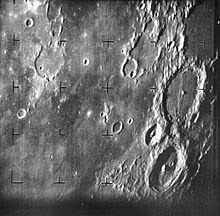The Race in Space...the Beginning occurred with the establishment of NASA on July 29, 1958. The first NASA 10-year plan was presented to Congress in February 1960. It called for an expanding program on a broad front: manned flight, scientific satellites, lunar probes, and to photograph the Moon... . Of course, that is not all but a good stopping point since the latter is the topic of today's history lesson.
This Day in History: July 31, 1964
 |
| A Harvest Moon |
Let's take a closer look...
 |
| Ranger 7 |
"Ranger 7 reached the Moon on 31 July. The F-channel began its one minute warm up 18 minutes before impact. The first image was taken at 13:08:45 UT at an altitude of 2110 km. Transmission of 4,308 photographs of excellent quality occurred over the final 17 minutes of flight. The final image taken before impact has a resolution of 0.5 meters." [Source: en.wikipedia.org]
Last picture by Ranger 7, taken about 488 m above the Moon,
reveals features as small as 38 cm across.
The noise pattern at right results from
spacecraft impact while transmitting.
reveals features as small as 38 cm across.
The noise pattern at right results from
spacecraft impact while transmitting.
Now, where IS that 'man in the moon'?


No comments:
Post a Comment